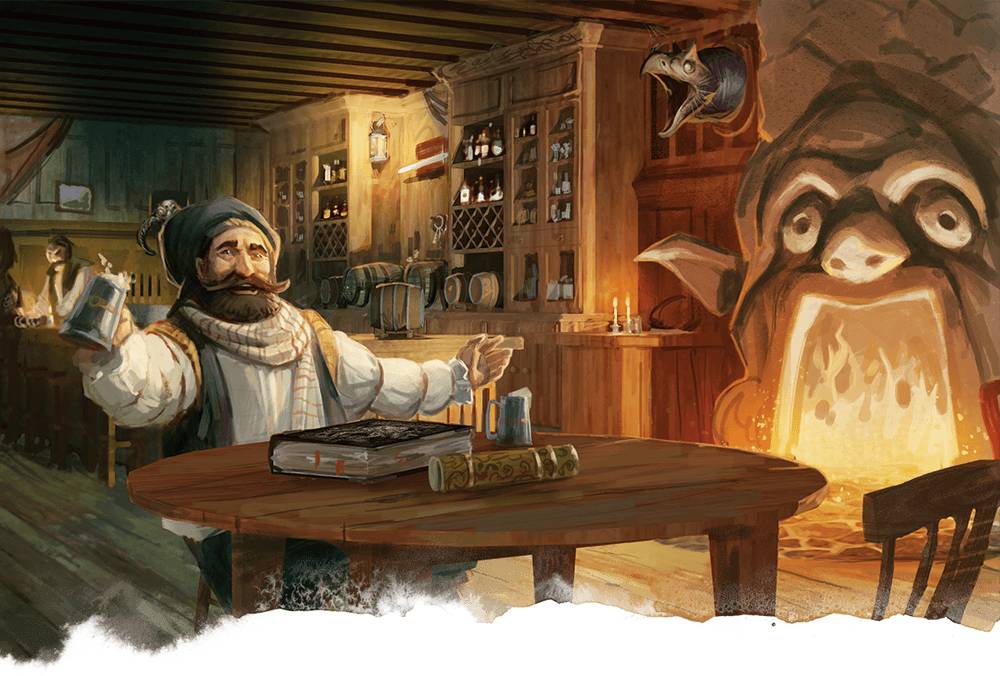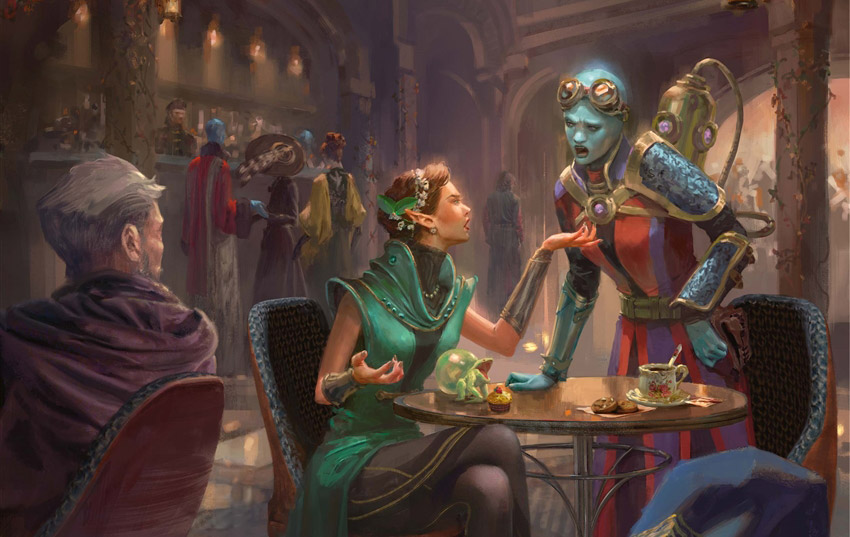


How to Get Better at Roleplaying in D&D
For many of us in our D&D journey, the earliest rites of passage into tabletop roleplaying are the mechanics: picking classes, species, and assigning stats. But often one of the most intimidating parts to a new player is the roleplay in roleplaying games. Moving a character around a fully immersive world for the first time can be tough to get used to.
Truth is, if you ever played make-believe as a child, pretended to be different characters with your friends, or narrated the actions of your toys, you’ve roleplayed. Much of what we do in tabletop RPGs like Dungeons & Dragons is heighten childhood make-believe games to a more intricate narrative that involves a group, a Dungeon Master, and some dice. Today, we’ll help you build on those basics to get your characters off the page and into the story.
How to Start Roleplaying
If you’ve never done much roleplaying or acting before, it can take some getting used to. How do you begin piloting another person who lives in a world you’ve never visited? Well, I have an exercise that will feel kind of silly, but bear with me.
Start with someone you might know a little better, yourself. Pick an everyday activity of yours, something like making toast. Now, either in your head or out loud if you’re in a space where you feel comfortable, just narrate the steps. Walk yourself through the process of grabbing your bread, picking your setting on the toaster, and spreading the butter or jam, for example. Describe it how you would if you were showing a clip of it to someone else.
If you’ve already started building your character, try to imagine how they might approach some of the same tasks you perform in your everyday life. If you haven’t made a character yet, pick a character you know pretty well from a favorite movie, book, or TV show. What things might this character do differently than you? What might be the same?
This simple exercise can get you in the habit of thinking outside your head, of viewing the world of your game in narrative terms. At its core, this is mostly what you’ll be doing when roleplaying, except instead of making toast, you’ll be describing things like how you cast spells, investigate dungeons, or have conversations with nonplayer characters, or NPCs.
First-Person vs. Third-Person Roleplay
When narrating your character’s actions, here are two main approaches: first-person roleplay and third-person roleplay.
In first-person, you might fully take on the identity of your character and speak in “I” or “my” type statements, such as “I hold my crusty bread over the candle flame on the tavern table until it is browned and crispy.” In “third-person roleplay,” you narrate the actions your character does, often using third-person pronouns such as he/she/they. For example, “Velma approaches the innkeeper and gives them 2 copper for toasted bread and a cup of coffee.”
Both of these approaches are valid ways to roleplay, and you should feel encouraged to pick the one that is most comfortable to you. Many players find that they have a preference for one way or the other. Some players find they can connect to a character better by getting fully in their head, for example, while others find that having a little bit of distance helps picture their character more fully. The best option is the one that gets you the most comfortable moving your character through your DM’s story.
6 D&D Roleplaying Tips
So we talked about the basics of how to start roleplaying, but how do you build that character to the point where you understand how they tick? If you’re still trying to build a character and figure out how to roleplay as them, here are some tips to get you started:
1. Use your background
While much of the character creation process focuses on your character’s class and ancestry, there’s a third element that often gets overlooked: your background. Picking your character’s background can be the first step between a blank slate and a backstory.
The Basic Rules have a whole section of backgrounds fitting various archetypes like criminal or folk hero, plus rules for how to customize your own. The characteristics section of each background can give you a step-by-step guide to figuring out how to roleplay your character. If you’re stuck thinking of an idea, you can read these for inspiration or even roll a die to pick one at random. We also have a guide to crafting a backstory using your background.
2. Build off your party
Roleplaying as part of a gaming table is not something you have to shoulder on your own. You don’t need to feel pressured to carry the story. Your character and your roleplay are like a puzzle piece fitting into a larger picture.
Listening to your party and what the other players and their characters are bringing to the table can help you find where you fit. Do you and another character have a rivalry? Maybe find moments when your character might try to one-up them. Maybe you and another character have a sibling-style relationship, giving each other a hard time between you but fiercely having each other's backs when it comes to outsiders.
3. Think of quirks or memorable traits for your character
Just having a few simple behavioral quirks or personal traits can do wonders for fleshing a character out. Even just having a handful of behaviors you know you can draw from can help you to understand how they might act in various situations. Do they lay on the charm when trying to get info out of people? Are they unable to process sarcasm? Do they have a hero complex? If you’re looking for help figuring out your character’s traits, see below for how the Player's Handbook prompts can give you a head start.
4. 'Yes, and'
As you begin to roleplay with other people, what you’re doing is a form of improvisation. Knowing some of the basic tools of improv can help you to get started.
One of the most common of these is to try to “yes, and,” which means accepting things that others in the game state as the truth, and then building from that. If someone says “That town is full of thieves and cutthroats,” don’t respond with “Actually they’re all farmers and librarians.” Think instead of how your character could build on that previous statement. Something like, “Oh yeah, my cousin got pickpocketed there.”
5. 'No, but'
Characters won’t always agree with each other, just like people don’t always agree in real life. Using a similar improv tool, “No, but,” you can create a conflict of ideas between characters while still adding to and building on the story the others have established.
Using the above example, if someone says a town is full of criminals, your character might acknowledge that reputation exists but feel it’s unfair. “Outsiders often feel that way, but when you get to know the place there’s a lot of good people.” Now you’re disagreeing with the reality they put forth, but you’ve done so in a way that builds the world.
6. Be willing to be foolish
One of the biggest hangups that new players have when getting into roleplaying is that sense of inhibition of truly opening up and embracing the play part of “roleplay.” But you are playing a game! It’s okay to have fun. Let yourself embrace the big boldness of a boisterous character or the mustache twirliness of a scoundrel.
What to Avoid When Roleplaying
We’ve talked a lot about some ways to expand your roleplaying, but here are a few things you may want to avoid, especially when just starting out.
- Don’t worry about being a voice actor: You may have discovered D&D after seeing it on a popular actual-play show such as Critical Role, Dimension 20, or Battle for Beyond. A great thing to remember about all of those shows is that their casts of players have been working as professional performers for years, even decades in some cases, and those shows are consciously being produced for an audience. You do not need to train yourself to do a different voice for your character to play D&D.
-
Don’t feel like you have to play a character with your same social skills: No one expects a D&D player to be able to win the same battles their character can. So why would we expect you to be as charming, wise, or intelligent as your character’s sheet? Part of the fun of roleplay is in being able to roll up someone different than ourselves. Plus that’s what the dice and character sheet are for! This is a great example of a time when third-person roleplay may be more comfortable for you, allowing you to describe what your character does instead of acting it out and then rolling dice to see if it’s successful.
-
Don’t forget to keep others in mind when roleplaying: One of the least popular phrases to utter at a D&D table is an indignant, “Well that’s just what my character would do.” Remember that everyone is coming to the table to tell a collective story and everyone should feel welcome and comfortable at that table together. At the end of the day, you are still responsible for the things you say and do as your character, including if you hurt or upset someone. That doesn’t mean difficult or combative characters can’t be part of a game, but having open conversations ahead of time and making sure everyone is on the same page out of character will go a long way toward a positive group experience.
-
Don’t forget to include your entire party: Sometimes your character may be the focus of the scene, but other times the focus will be on others, or on the group as a whole. As exciting as it can be to play your character, it’s important to let everyone at the table get a chance to play. Look for opportunities to set other players up to have great moments!
-
Try to keep personal conflicts out of character: If something about the game is bothering you or making you uncomfortable, it’s better to stop playing and talk it out or to approach the DM earnestly during a break in the game to discuss it. Similarly, don’t let in-character conflicts bleed into out-of-character arguments.
Tips for DMs to Get Your Players Roleplaying
If you’re a Dungeon Master and you’ve got players who are new to roleplaying, here are some suggestions for getting them more into the groove.
-
Start small: Having in-character conversations can be intimidating at first. Players might feel anxious leading a conversation with a noble or someone giving them an important quest, for fear they might “do it wrong” and mess up the game somehow. Give them some low-stakes roleplay opportunities, such as talking to a shopkeep or a tavern owner, to get them comfortable interacting in character.
-
Address characters directly: We’ve all been there as a DM. We ask the group a question, and they all look at each other and clam up. If you’re still trying to get players comfortable with responding to questions in game, have an NPC address the characters individually. If you notice certain players still hesitant to engage, allow them to come out of their shells a bit by giving them chances to do so.
-
Give players opportunities to flesh out their character: Read over the players’ backstories and backgrounds and make sure to note things that could be good roleplaying hooks for games. Then during the story, you can poke at them with conversations that ask them about their past, and any trinkets they may carry, or try to give them opportunities to act on their flaws or ideals. Using something they created in your narrative can go a long way toward making them feel invested in the story.
-
Give players opportunities to talk amongst themselves in character: Give your characters space in the narrative to talk to each other, such as when planning to embark on a quest, or when resting for the evening at a tavern or an inn. Use an NPC to get them started if need be, but if you pepper in their individual quirks and traits in the story, they should start to feel curious enough to ask each other.
-
Respect the players’ comfort zones: While all these suggestions are designed to draw players out, it is good to also let them move at a pace they are comfortable with. It’s also important to let them roleplay how they feel more confident, so even if you’re a fan of first-person roleplay, for example, be willing to be flexible and allow players to do third-person if that’s how they can more actively engage with the game.
Set Expectations With a Session Zero
Before embarking on an adventure, it can be beneficial to have what’s called a session zero. This is time you set aside before playing the game to talk to your players about what they hope to get out of the game. You should also explore topics they are or are not comfortable with. When DMing for new players, this is a great time to also set expectations for the game.
Conclusion
Roleplaying, like everything else about a new hobby, is something that takes time and practice to get better at. Some things will feel a little awkward and unnatural at first. With patience and a willingness to cooperate with your fellow gamers, it can soon grow into one of the most fun parts of the game.
By RILEY SILVERMAN
Made with GM Binder
www.gmbinder.com

Roleplaying
For many of us in our D&D journey, the earliest rites of passage into tabletop roleplaying are the mechanics: picking classes, species, and assigning stats. But often one of the most intimidating parts to a new player is the roleplay in roleplaying games. Moving a character around a fully immersive world for the first time can be tough to get used to.
Truth is, if you ever played make-believe as a child, pretended to be different characters with your friends, or narrated the actions of your toys, you’ve roleplayed. Much of what we do in tabletop RPGs like Dungeons & Dragons is heighten childhood make-believe games to a more intricate narrative that involves a group, a Dungeon Master, and some dice. Today, we’ll help you build on those basics to get your characters off the page and into the story.
A DUNGEONS & DRAGONS supplement
for both DMs and players
For use with fifth edition
Player's Handbook, Monster Manual,
and Dungeon Master's Guide
DUNGEONSANDDRAGONS.COM

